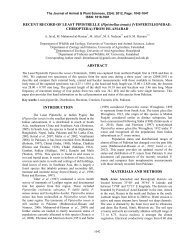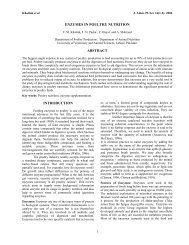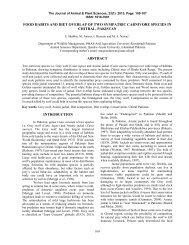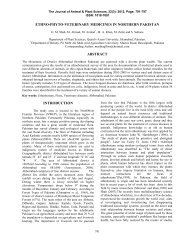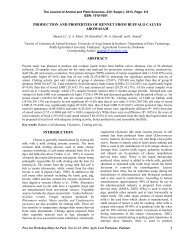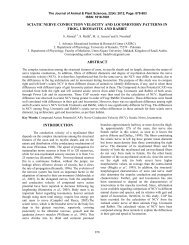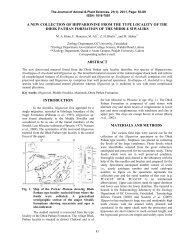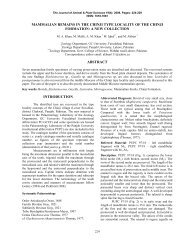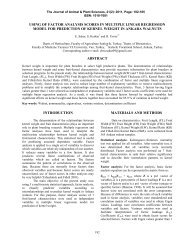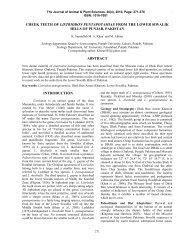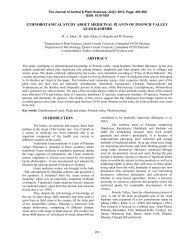ksk 133-a high yielding, stiff stemmed and - Journal of Animal and ...
ksk 133-a high yielding, stiff stemmed and - Journal of Animal and ...
ksk 133-a high yielding, stiff stemmed and - Journal of Animal and ...
You also want an ePaper? Increase the reach of your titles
YUMPU automatically turns print PDFs into web optimized ePapers that Google loves.
Akhter et al. J. Anim. Pl. Sci. 17(3-4): 2007<br />
KSK <strong>133</strong>-A HIGH YIELDING, STIFF STEMMED AND EXTRA LONG GRAIN COARSE<br />
RICE VARIETY<br />
M. Akhter, M. Ahmad. M. Ramzan * <strong>and</strong> T. H. Awan<br />
Rice Research Institute, Kala Shah Kaku, Pakistan * PARC Rice Programme, Kala Shah Kaku<br />
ABSTRACT<br />
A <strong>high</strong> <strong>yielding</strong>, <strong>stiff</strong> <strong>stemmed</strong> <strong>and</strong> extra long grain coarse rice variety was developed by crossing KS282 <strong>and</strong> advance<br />
line 4321. It was tested in series <strong>of</strong> station <strong>and</strong> national yield trials during 1991-2003 for yield performance reaction to<br />
insect pests <strong>and</strong> diseases <strong>and</strong> grain quality. It was compared with KS282 in 64 trials. It exceeded KS282 by 7.58% <strong>and</strong><br />
IR6 by 5.16% in station trials. In national trials i.e. NURYT 1998 <strong>and</strong> 1999, it out yielded KS282 by 7.77 %. In regional<br />
adoptability trials its superiority over local check was 10%. Overall, it had 8.6% <strong>and</strong> 18% yield edge over KS282 <strong>and</strong><br />
IR6, respectively. The stem <strong>and</strong> leaves <strong>of</strong> KSK <strong>133</strong> remains green at the time <strong>of</strong> maturity. Therefore, can be used as a<br />
green fodder. It had similar response to insect pests <strong>and</strong> diseases as KS282. The new variety KSK<strong>133</strong> is moderately<br />
resistant to bakanae / foot rot <strong>and</strong> paddy blast. In physico-chemical tests conducted at Rice Research Institute, Kala Shah<br />
Kaku, head rice recovery <strong>and</strong> grain length are more than KS282. Its grain is bold so it can not be mixed with any<br />
Basmati variety. It was approved for cultivation by Punjab Seed Council, Government <strong>of</strong> the Punjab <strong>and</strong> VEC at the<br />
Federal level in 2006.<br />
Key words: Rice; variety; breeding, <strong>high</strong> <strong>yielding</strong>, Pakistan.<br />
INTRODUCTION<br />
Plant breeding is a continuous process<br />
(Poehlman <strong>and</strong> Borthakur, 1959; Singh et. al., 2000).<br />
Society supports plant breeders for only one purpose: to<br />
develop more productive varieties for farm use (Jenning<br />
et.al., 1979; Hallauer, 1981). Genetic improvement in rice<br />
plant made a great contribution to achieving food security<br />
in Asia over the last 3 decade (Hossain <strong>and</strong> Fischer,<br />
1995; Khush, 1995; Hossain, 1996). Human needs for<br />
plentiful, rich <strong>and</strong> cheap food dictate continuous research<br />
for new varieties. Several other factors compel changes.<br />
The variety complex under goes changes in response to<br />
biotic <strong>and</strong> a biotic compulsions (Rothchild,1996; Singh<br />
et. al., 2000; Mann 1999). Rice Research Institute, Kala<br />
Shah Kaku is a premier Rice Research Organization. It is<br />
actively involved in the development <strong>of</strong> new Basmati <strong>and</strong><br />
non-basmati rice varieties that are <strong>high</strong> <strong>yielding</strong>, <strong>stiff</strong><br />
<strong>stemmed</strong> <strong>and</strong> possess good cooking <strong>and</strong> eating quality<br />
(Akram et. al., 2006, Ahmad <strong>and</strong> Akram, 2005). Every<br />
year, hundreds <strong>of</strong> new lines are tested for these attributes<br />
in Punjab to meet the food requirements <strong>and</strong> farm sector<br />
welfare (Anonymous, 1996).<br />
KS282 replaced IR6 in 1982 due to its <strong>high</strong>er<br />
yield <strong>and</strong> earliness. KS 282 remained popular for a long<br />
time. Presently, the farmers <strong>of</strong> non traditional rice area<br />
i.e., Jhang, Okara <strong>and</strong> Pakpattan districts, are dem<strong>and</strong>ing<br />
a <strong>high</strong> <strong>yielding</strong> <strong>and</strong> <strong>stiff</strong> <strong>stemmed</strong> coarse rice variety<br />
having better yield <strong>and</strong> grain quality than KS 282.<br />
Keeping this scenario in view, scientists at RRI Kala<br />
Shah Kaku put their efforts to develop a <strong>high</strong> <strong>yielding</strong>,<br />
<strong>stiff</strong> <strong>stemmed</strong> <strong>and</strong> extra long grain rice variety KSK<strong>133</strong>.<br />
63<br />
It was released for general cultivation by Punjab Seed<br />
Council <strong>and</strong> the VEC in 2006.<br />
MATERIALS AND METHODS<br />
KSK<strong>133</strong> with pedigree PK 4154-11-1-1 has<br />
been evolved by hybridizing KS 282 <strong>and</strong> 4321(PK 198-<br />
12-3-2-1-1) in 1985 at Rice Research Institute, Kala Shah<br />
Kaku (RRI, KSK). KS 282 is a <strong>high</strong> <strong>yielding</strong>, early<br />
maturing <strong>and</strong> coarse grain rice variety whereas, 4321 is<br />
also <strong>high</strong> <strong>yielding</strong>, tall line with excellent cooking<br />
quality.<br />
Subsequent segregating generations were<br />
h<strong>and</strong>led in a pedigree arrangement. In F5, progeny <strong>of</strong> a<br />
single panicle was bulked for yield testing disease <strong>and</strong><br />
quality evaluation. The pedigree method <strong>of</strong> selection<br />
continued with the pedigree No. PK 4154-11-1-1. Then<br />
this line was evaluated in observational plots / lines with<br />
entry No. <strong>133</strong>. It was tested in observational trial, coarse<br />
grain yield trials, micro plot yield trials <strong>and</strong> regional<br />
adaptability trials (National Uniform Yield Trials) from<br />
1991 to 2003.<br />
KSK <strong>133</strong> was tested in a series <strong>of</strong> station yield<br />
trials in a r<strong>and</strong>omized complete block design with four<br />
replications from 1993 to 2001 (Table 1). The nursery<br />
was raised by conventional method i. e., seed soaking (24<br />
hours), Incubation (48 hours) <strong>and</strong> broadcasting <strong>of</strong><br />
sprouted seed in the puddled soil / field. The seed rate<br />
was 20-22 kg / hectare. The plot size for each treatment<br />
was 1.8m x 6.75m. Thirty days old seedlings were<br />
transplanted with a plant spacing <strong>of</strong> 22.5 cm x 22.5 cm.<br />
All st<strong>and</strong>ard agronomic practices were adopted.
Akhter et al. J. Anim. Pl. Sci. 17(3-4): 2007<br />
The new variety KSK <strong>133</strong> along with KS 282<br />
was tested for adaptability for four years at different<br />
locations in Punjab in a r<strong>and</strong>omized complete block<br />
design with four replications (Table 2). National Uniform<br />
Rice Yield Trials (NURYT) are conducted by a Federal<br />
Organization (PARC) to ensure neutral assessment.<br />
NURYT were planted in a r<strong>and</strong>omized block design with<br />
three replications. The plots size was 3m x 5 m.<br />
Transplanting date trials were conducted at RRI,<br />
Kala Shah Kaku for four years to determine the optimum<br />
time <strong>of</strong> transplanting <strong>of</strong> this new line as mentioned in<br />
Table 4. The experiment was laid out in R<strong>and</strong>omized<br />
complete Block Design with three replications <strong>and</strong> plot<br />
size was 2mx9m. The transplanting dates were i.e. 16/5,<br />
1/6, 16/6, 1/7, 16/7 <strong>and</strong> 1/8.At harvest individual plot was<br />
harvested <strong>and</strong> threshed at site to record yield. Analysis <strong>of</strong><br />
each site was done following st<strong>and</strong>ard analysis <strong>of</strong><br />
variance technique (Steel et al. (1997). Variety<br />
characteristics were recorded during national testing<br />
(Anonymous, 1996). Reaction against diseases <strong>and</strong><br />
insects was recorded both at provincial <strong>and</strong> federal levels.<br />
Quality assessment was made using the st<strong>and</strong>ard methods<br />
(Dela Cruz <strong>and</strong> Khush, 2000) by public <strong>and</strong> private<br />
sector.<br />
RESULTS AND DISCUSSION<br />
Yield <strong>and</strong> adaptability: The results <strong>of</strong> station yield trials<br />
are summarized in Table 1. New variety KS<strong>133</strong> gave<br />
significantly <strong>high</strong>er yield than KS282 <strong>and</strong> IR6 except<br />
during 1994 <strong>and</strong> 1997. On the average <strong>of</strong> 9 years,<br />
KSK<strong>133</strong> gave 7.6 % <strong>and</strong> 5 % <strong>high</strong>er yield than KS282<br />
<strong>and</strong> IR6, respectively. In regional adaptability trials the<br />
new variety KSK<strong>133</strong> produced 5.5 t/ha while the yield <strong>of</strong><br />
the check variety KS 282 was 5.0 t/ha. In this way KSK<br />
<strong>133</strong> gave 10 percent <strong>high</strong>er yield than check variety on<br />
the average <strong>of</strong> four years (Table 2).<br />
Table 1 Paddy yield (t/ha) <strong>of</strong> KSK <strong>133</strong> in station yield<br />
trials<br />
Year KSK <strong>133</strong> KS 282 IR 6<br />
1993 5.12 a<br />
4.07b 4.87 a<br />
1994 4.03 ns<br />
4.28 4.01<br />
1995 4.06 ns<br />
3.99 3.96<br />
1996 5.56 ns<br />
4.65 4.27<br />
1997 4.45 abc<br />
4.81 ab<br />
4. 70ab<br />
1998 3.46 ns<br />
3.32 3.74<br />
1999 5.41 ns<br />
4.96 5.11<br />
2000 4.65 ns<br />
4.05 4.47<br />
2001 5.45 ns<br />
5.11 5.02<br />
Average Yield 4.69 4.36 4.46<br />
Percentage increase<br />
over check varieties<br />
7.6 + 5<br />
64<br />
Table 2 Paddy yield (t/ha) <strong>of</strong> KSK <strong>133</strong> in regional<br />
adoptability trials<br />
Year<br />
Location<br />
Varieties / paddy yield<br />
(t/ha)<br />
KSK <strong>133</strong> KS282<br />
Farooqabad 4. 26ns<br />
1997<br />
Gujranwala<br />
ns<br />
4.93<br />
3.96<br />
4.57<br />
Kala Shah Kaku 4.50 ns<br />
1998<br />
Farooqabad<br />
ns<br />
4.95<br />
4.36<br />
4.85<br />
Faisalabad 6.55 ns<br />
5.54<br />
Kala Shah Kaku 5.08 ns<br />
4.65<br />
Chakanwali 6.99 ns<br />
6.96<br />
Gujranwala 6.80 ns<br />
2002<br />
6.43<br />
Shor Kot 4.78 ns<br />
4.25<br />
Kala Shah Kaku 5.61 a<br />
5.24 ab<br />
Farooqabad 5.62 a<br />
5.41 ab<br />
Gujranwala 5.23 a<br />
4.88 ab<br />
Faisalabad 6.41 a<br />
5.45 abc<br />
Shor Kot 5.54 a<br />
4.20 bc<br />
Chakanwali 6.10 ns<br />
2003<br />
5.69<br />
Sialkot 4.79 a<br />
3.72 b<br />
Average <strong>of</strong> four years 5.50 5.00<br />
Percentage increase <strong>of</strong><br />
KSK<strong>133</strong> over<br />
- + 10%<br />
Table 3 Paddy yield (t/ha) <strong>of</strong> KSK<strong>133</strong> in NURYT<br />
during 1998 ND 1999<br />
Year Location<br />
Varieties / paddy yield<br />
(t/ha)<br />
KSK<strong>133</strong> KS282<br />
Kala Shah Kaku 1.95 ab<br />
1.72 ab<br />
Pindi Bhattian 4.78 ab<br />
4.67 ab<br />
Faisalabad 4.33 b<br />
4.03 c<br />
NARC 5.10 a<br />
4.68 ab<br />
Dokri 5.33 bc<br />
6.60 a<br />
T<strong>and</strong>ojam 4.51 a<br />
3.62 c<br />
D.I.Khan 2.83 b<br />
2.50 b<br />
1998<br />
Usta Muhammad 2.49 a<br />
1.91 b<br />
Kala Shah Kaku 5.19 a<br />
4.59 abc<br />
Pindi Bhattian 5.29 ab<br />
5.52 a<br />
Sialkot 5.42 ab<br />
5.83 a<br />
Gujranwala 6.79 a<br />
5.39 a<br />
Faisalabad 6.21 b<br />
6.20 b<br />
Farooqabad<br />
D.I.Khan<br />
4.33<br />
6.33<br />
4.04<br />
a<br />
4.00 ab<br />
Mingora 4.27 a<br />
2.75 b<br />
Dokri 7.07 6.73<br />
Jamra 8.10 8.27<br />
T<strong>and</strong>ojam 6.92 c<br />
6.19 b<br />
1999<br />
Usta Muhammad 5.36 a<br />
5.91 a<br />
Average <strong>of</strong> two years 5.13 4.76<br />
Percent increase over - +7.77
Akhter et al. J. Anim. Pl. Sci. 17(3-4): 2007<br />
Results <strong>of</strong> the National Uniform Yield Trials<br />
conducted during 1998 <strong>and</strong> 1999 are reported in Table-3.<br />
The result indicate that KSK<strong>133</strong> got the average yield <strong>of</strong><br />
5.13 t/ha in comparison with the check variety (KS282).<br />
The new variety produced 7.77% <strong>high</strong>er yield than<br />
KS282. KSK <strong>133</strong> produced 6.0 % <strong>high</strong>er yield than KS<br />
282 in the Punjab locations.<br />
Table 4 Paddy yield (t/ha) <strong>of</strong> KSK <strong>133</strong> in date <strong>of</strong><br />
transplanting date trials<br />
Year / Transplanting dates / paddy yield ( t/ha )<br />
Variety Ist 16<br />
June<br />
th<br />
1<br />
June<br />
st<br />
16<br />
July<br />
th<br />
1<br />
July<br />
st<br />
Average<br />
1998-1999<br />
August<br />
KSK<strong>133</strong> - 3.91 3.89 2.88 1.87 3.14<br />
KS282 - 3.31 4.03 2.77 1.87 3.00<br />
IR6 - 2.97 3.83<br />
1999-2000<br />
2.9 1.92 2.91<br />
KSK<strong>133</strong> 4.61 5.56 4.55 4.79 3.71 4.64<br />
KS282 2.83 4.76 4.86 4.28 3.37 4.02<br />
IR6 4.63 4.92 4.73<br />
2000-2001<br />
4.48 3.72 4.50<br />
KSK<strong>133</strong> 5.63 5.74 5.32 4.52 3.82 5.01<br />
KS282 4.38 5.40 4.82 3.24 3.37 4.27<br />
IR6 5.01 5.05 4.71<br />
2001-2002<br />
3.37 3.37 4.30<br />
KSK<strong>133</strong> 4.55 6.12 6.33 5.12 4.68 5.39<br />
KS282 4.44 5.94 5.73 5.06 3.81 5.10<br />
Average <strong>of</strong> four years<br />
KSK<strong>133</strong> 4.93 5.33 5.02 4.33 3.52 4.78<br />
KS282 3.88 4.85 4.86 3.84 3.11 4.36<br />
IR6 4.82 4.31 4.42 3.58 3.00 4.03<br />
The average <strong>of</strong> four years YIELD data <strong>of</strong><br />
KSK<strong>133</strong> indicates that the <strong>high</strong>est yield 5.33 t/ha was<br />
obtained from the transplanting <strong>of</strong> 16June whereas the<br />
transplanting <strong>of</strong> Ist August gave the lowest yield (3.52<br />
t/ha) (Table 4). The data indicate that the maximum yield<br />
<strong>of</strong> KSK<strong>133</strong> can be obtained if transplanted during mid<br />
June to Ist week <strong>of</strong> July.<br />
In total, sixty four (64) trials were conducted to<br />
compare new variety KSK<strong>133</strong> with KS282 <strong>and</strong> IR6 for<br />
yield <strong>and</strong> adaptability. The over all average <strong>of</strong> KSK<strong>133</strong><br />
was 5.02 t/ha against 4.62 t/ha <strong>and</strong> 4.25 t/ha <strong>of</strong> KS282<br />
<strong>and</strong> IR6 respectively. The new variety KSK <strong>133</strong> gave<br />
8.6% <strong>high</strong>er yield than commercial variety KS282.<br />
Furthermore, it also out yielded IR6 / IR9 by 18.0%<br />
(Table 5).<br />
In conclusions, the paddy yield <strong>of</strong> KSK<strong>133</strong> is<br />
8.60 % <strong>and</strong> 18.0 % <strong>high</strong>er than KS282 <strong>and</strong> IR6,<br />
respectively. The stem <strong>and</strong> leaves <strong>of</strong> KSK <strong>133</strong> remains<br />
green till the time <strong>of</strong> maturity. Therefore, can be used as a<br />
green fodder. KSK <strong>133</strong> fits well in the rice-potato <strong>and</strong><br />
rice-peas <strong>and</strong> rice-berseem fodder rotation. The quality<br />
characteristics like grain length, head rice recovery <strong>and</strong><br />
65<br />
cooked grain length <strong>of</strong> KSK <strong>133</strong> are also better than KS<br />
282.<br />
Table 5 Summery <strong>of</strong> yield trials<br />
Paddy Yield (t/ha) Percent<br />
Name <strong>of</strong> trial<br />
No. <strong>of</strong><br />
Trials KS IR6/ KSK<br />
increase over<br />
KS IR6/<br />
282 IR9 <strong>133</strong> 282 IR9<br />
Varietal yield<br />
trials<br />
9 4.36 4.46 4.69 +7.58 +5.16<br />
Micro plot<br />
yield trials<br />
16 5.00 - 5.50 +10.00 -<br />
National<br />
uniform yield<br />
trials<br />
20 4.76 - 5.13 +7.77 -<br />
Sowing date<br />
trials<br />
19 4.36 4.03 4.78 +10.0 +19.0<br />
Average 4.62 4.25 5.02 +8.6 +18.0<br />
Table 6: Quality traits <strong>of</strong> KSK <strong>133</strong> in comparison with<br />
the check<br />
Characters<br />
Name <strong>of</strong> variety<br />
KS 282 KSK <strong>133</strong><br />
Paddy<br />
Av. Length (mm) 9.82 10.05<br />
Av. Width (mm) 2.35 2.45<br />
Av. Thickness (mm)<br />
Rice kernel<br />
1.96 2.08<br />
Av. Length (mm) 6.83 7.07<br />
Av. Width (mm) 2.03 2.11<br />
Av. Thickness (mm) 1.54 1.79<br />
Boiled kernel length (mm) 11.58 12.13<br />
Total milling recovery % 71.68 72.77<br />
Head rice % 53.99 57.51<br />
Broken % 19.86 15.65<br />
Amylose content % 29.31 27.10<br />
Alkali spreading value 6.50 (low) 5.33 (low)<br />
Protein content % 8.63 8.52<br />
Gel consistency (mm) 47.33 55.33<br />
1000 grain weight (gm) 19.05 21.0<br />
Resistance against insect pests <strong>and</strong> diseases: Pest<br />
population was recorded at Rice Research Institute, Kala<br />
Shah Kaku under non-sprayed conditions for three years<br />
i.e., 2000, 2001 <strong>and</strong> 2004. KSK<strong>133</strong> was also tested<br />
during 1995 <strong>and</strong> 2001 against paddy blast, bacterial leaf<br />
blight <strong>and</strong> stem rot at Rice Research Institute, Kala Shah<br />
Kaku. The response <strong>of</strong> the new line was the same with<br />
the check varieties against insects <strong>and</strong> diseases.<br />
Grain Quality: Quality analysis were made by<br />
RRI,KSK, Rice Programme NARC, Islamabad <strong>and</strong> two<br />
private rice exporters. Average values from all the four<br />
sources are given in Table 6. KSK <strong>133</strong> has longer paddy
Akhter et al. J. Anim. Pl. Sci. 17(3-4): 2007<br />
<strong>and</strong> milled rice grain than KS 282. Furthermore, its grain<br />
is bolder than the check variety. In milling, head rice<br />
recovery is a very important character. The head rice<br />
recovery <strong>of</strong> KSK <strong>133</strong> was 57.51 % with compared to the<br />
check variety which was 53.99 %.<br />
Table 7 Description <strong>of</strong> KSK <strong>133</strong> in comparison with<br />
existing commercial variety ‘ks 282’<br />
S.<br />
No.<br />
Characteristics KS 282 KSK <strong>133</strong><br />
1 Plant height (cm) 106 114<br />
2 Leaf colour Green Green<br />
3 Leaf angle Semi erect Semi erect<br />
4 Stem <strong>stiff</strong>ness Semi <strong>stiff</strong> Stiff<br />
5 Productive tillers 18 19<br />
6 Grains per panicle 122 102<br />
7 Maturity days 101 105<br />
8 1000 grain weight<br />
(paddy) (g)<br />
26.4 28.9<br />
REFERENCES<br />
Ahmad,. M <strong>and</strong> M. Akram (2005). H<strong>and</strong> book on rice<br />
varieties in Pakistan. Rice Research Institute,<br />
Kala Shah Kaku.<br />
Akram, M., A. Rehman, <strong>and</strong> M. Salim (2006). Rice<br />
varietal improvement in Pakistan: role <strong>of</strong><br />
international rice germplasm. In Proceedings <strong>of</strong><br />
the International Seminar on rice crop. Oct 2-3,<br />
2006. Rice Research Institute, Kala Shah Kaku.<br />
P. 8-15.<br />
Anonymous (1996). St<strong>and</strong>ard evaluation system for rice.<br />
IRRI..<br />
Dela Cruz, N. <strong>and</strong> G.S. Khush (2000). Rice grain quality<br />
evaluation procedures. In Aromatic Rices edited<br />
by R.K. Singh, U.S. Singh <strong>and</strong> G.S. Khush.<br />
Oxford & IBH Pub. Co. Pvt. Ltd, New Delhi. p<br />
14-27.<br />
66<br />
Hallauer, A.R. (1981). Selection <strong>and</strong> breeding methods.<br />
In Plant Breeding II edited by K.J. Frey. The<br />
Iowa State University Press.<br />
Hossain, M. <strong>and</strong> K.S. Fisher (1995). Rice research for<br />
food security <strong>and</strong> sustainable development in<br />
Asia: achievements <strong>and</strong> future challenges. Geo<br />
<strong>Journal</strong> 35: 286-298.<br />
Hossain, M. (1996). Economic prosperity in Asia:<br />
Implication for rice research. IRRI. Rice<br />
Genetics III. Proceedings <strong>of</strong> the third<br />
international rice genetics symposium. 16-20<br />
Oct., 1995, Manila, Philippines..<br />
Jenning, P.R., W.R. C<strong>of</strong>fman, <strong>and</strong> H.E. Kauffman 1979.<br />
Rice Improvement. International Rice Research<br />
Institute, Los Banos. Philippines.<br />
Khush, G.S. (1995). Breaking the yield frontier <strong>of</strong> rice.<br />
Geo <strong>Journal</strong> 35: 325-328.<br />
Mann, C.C. (1999). Crop scientists seek a new<br />
revolution. Science, 283: 310-314.<br />
Poehlman, J.M. <strong>and</strong> D. Borthakur (1959). Breeding Asian<br />
field crops. Oxford & IBH. Pub. Co..<br />
Rothchild, G. Forward (1996). IRRI. Rice Genetics III.<br />
Proceeding <strong>of</strong> the third international rice<br />
genetics symposium. 16-20 Oct.,1995, Manila,<br />
Philippines. p xvii-xviii..<br />
Singh R.K., G.S. Kush, U.S. Singh, A.K. Singh, <strong>and</strong><br />
Sanjay Singh (2000). Breeding aromatic rice for<br />
<strong>high</strong> yield, improved aroma <strong>and</strong> grain quality.<br />
In:Aromati rices. edited by R.K. Singh, U.S.<br />
Singh <strong>and</strong> G.S. Khush. Oxford <strong>and</strong> IBH<br />
Publishing Co. Pvt. Ltd. New Delhi. p. 71-105.<br />
Steel. R.G.D., J.H. Torrie <strong>and</strong> D.A. Dickey. (1997).<br />
Principles <strong>and</strong> Procedures <strong>of</strong> Statistics: A<br />
Biometric Approach (3 rd Ed.) McGraw-Hill<br />
Book Co., New York. USA.



